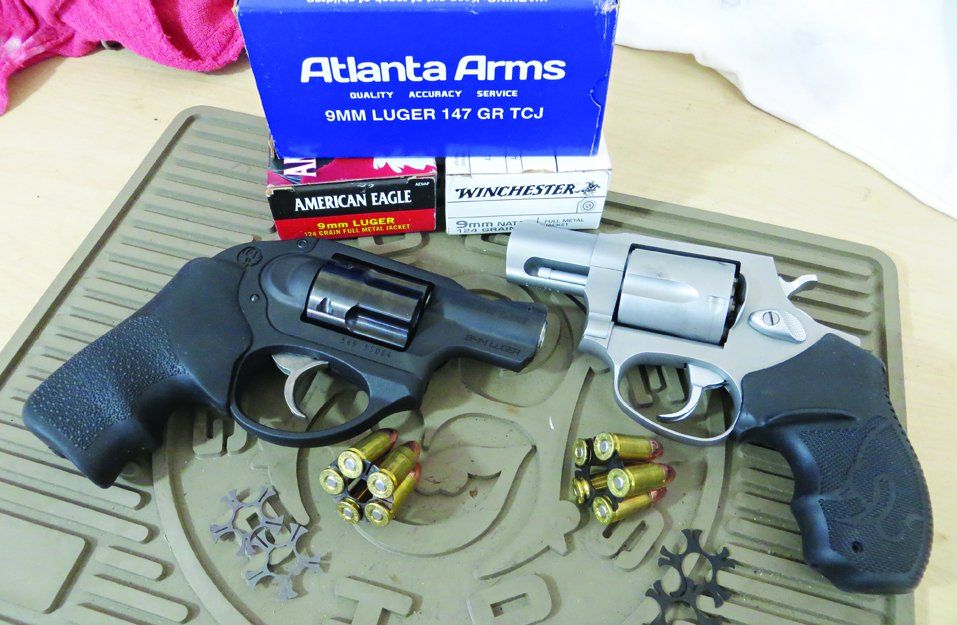
The 9mm is the most popular handgun cartridge in the world, in use with most military forces and LE agencies; in fact the FBI announced in 2014 that it is switching back to the 9mm after having used the 40 S&W since 1997. When we think snubnose revolvers, we typically think 38 Special, but since the mid-20th century, revolver manufacturers have been building short-barreled wheelguns chambered for 9mm semi-automatic pistol ammunition. In the past we tested two such 9mm Luger chamberings, an S&W Model 940 (C+) and Charter Arms Pitbull (A-). We noted then that 9mm compact semi-automatic pistols have an edge over 38 Special revolvers due to the semi-automatic’s higher round capacity, but in the revolver, the playing field between 38 Special and 9mm Luger is leveled, as far as round counts go.
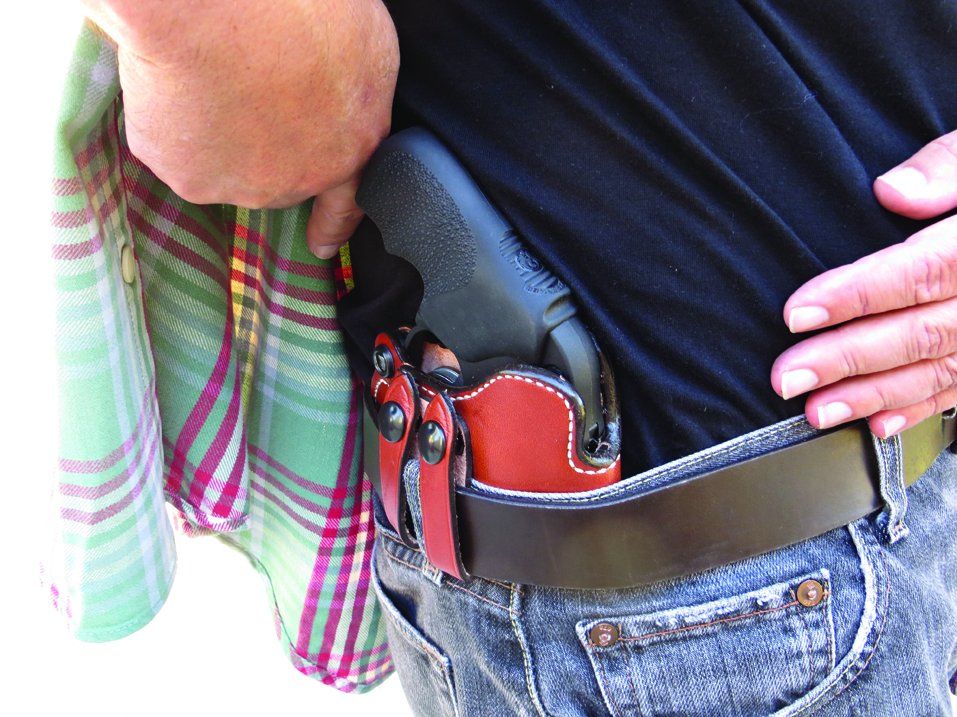
Now, ballistic technology has made the once underperforming 9mm better. We have done a number of tests comparing 9mm and 38 Special ammunition from short-barrel handguns, and, generally speaking, the 38 Special runs bullets with weights from 110 to 158 grains at muzzle velocities of 900 fps to 1000 fps. The typical 9mm uses bullet weights from 115 to 147 grains at speeds of 910 fps to 1100 fps. So the 9mm has a slight performance advantage over the 38 Special. A bigger nod goes to the availability and affordability of 9mm ammo, which can be found nearly anywhere in the world, and which domestically costs about 17 cents a round compared to 25 cents a round for 38 Special.
| RANGE DATA | ||
| American Eagle 9mm 115-gr. FMJ | Taurus 905 | Ruger LCR |
| Average velocity | 992 fps | 996 fps |
| Muzzle energy | 251 ft.-lbs. | 254 ft.-lbs. |
| Smallest group | 1.7 in. | 1.7 in. |
| Average group size at 15 yards | 2.1 in. | 2.1 in. |
| Winchester NATO 9mm 124-gr. FMJ | Taurus 905 | Ruger LCR |
| Average velocity | 1079 fps | 1077 fps |
| Muzzle energy | 321 ft.-lbs. | 319 ft.-lbs. |
| Smallest group | 0.7 in. | 0.9 in. |
| Average group size at 15 yards | 1.2 in. | 1.5 in. |
| Atlanta Arms 9mm 147-gr. FMJ | Taurus 905 | Ruger LCR |
| Average velocity | 808 fps | 811 fps |
| Muzzle energy | 213 ft.-lbs. | 215 ft.-lbs. |
| Smallest group | 1.1 in. | 0.9 in. |
| Average group size at 15 yards | 1.4 in. | 1.1 in. |
| To collect accuracy data, we fired five-shot groups from a bench using a rest. The Ruger was fired double action, and the Taurus was fired single action. We recorded velocities using a ProChrono digital chronograph with the first screen set 15 feet from the muzzle. | ||
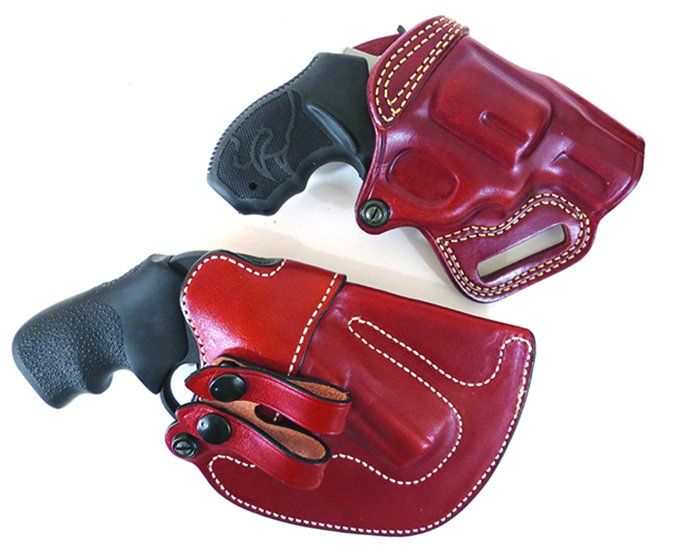
There are other reasons to look at 9mms in wheelguns. We feel the ability to swap ammo between our semi-auto and our revolver makes sense, with only one type of cartridge to purchase. New shooters usually find revolvers to be less complicated to operate, so if your home-defense backup isn’t familiar with semi-autos, you can still partner a high-cap 9mm semi-auto with a low-cap 9mm wheelgun pretty easily.
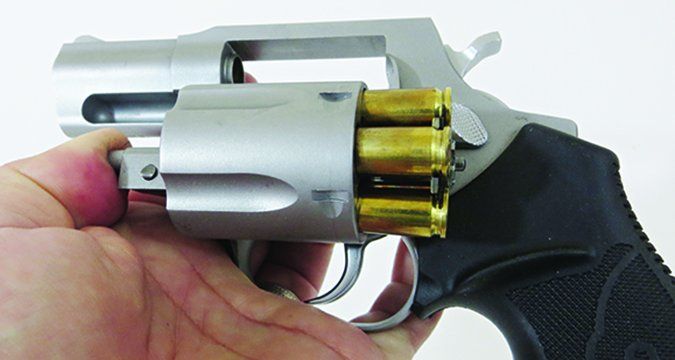
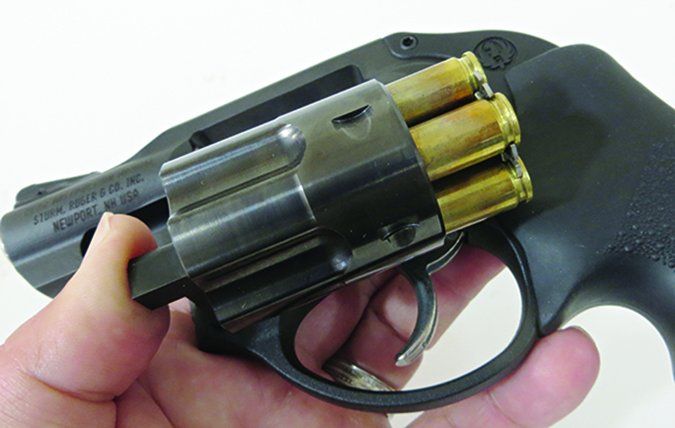
Though some testers groaned when they saw the 9mm revolvers in this test, saying they were as unnatural as three-wheel motorcycles, they put their prejudices aside and found these revolvers performed well at the range. The Ruger LCR Model 5456 9mm Luger debuted in 2014, and the Taurus 905 has been around since 2003. Unlike the Charter Arms Pitbull (which does not use moon clips, but instead employs a retention spring built into the ejector that fits under the 9mm cartridge’s rim), the LCR 9mm and the 905, like the S&W Model 940, use five-shot moon clips. Moon clips have been the standard convention when chambering semi-automatic cartridges in revolvers since 1917, when 45 ACP was chambered in S&W and Colt’s large-frame revolvers. Moon clips mean the revolver is fast to reload — nearly as fast as a magazine change in semi-auto. But, as we have found in the past, carrying a spare moon clip in one’s pocket can lead to bent clips, making them inoperable. Not that this a show stopper, just an attribute of moon clips in general. So don’t put a moon clip in your rear pants pocket and sit down. In fact we loaded both the Ruger and Taurus moon clips provided with the test guns and dropped them onto a concrete floor from waist height to see if the cartridges would fall out or the clips bend. A cartridge from each clip popped out after the drop, but there was no sign of bending. Another cost we looked at was how much moon clips go for. Brownells.com lists three moon clips for $12.99 (#780-001-371WB), less than one semi-auto magazine. The moon clips from Taurus and Ruger were not compatible with the other manufacturer’s revolver. We should note that single cartridges can be loaded into the chambers of the Ruger and Taurus wheelguns and fired safely, since the 9mm case headspaces on a step in the chambers. In that case however, extraction without a moonclip requires each case be pushed out with a pencil, pen, or similar skinny object.
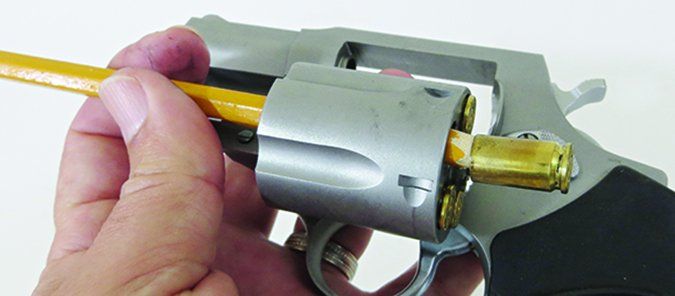
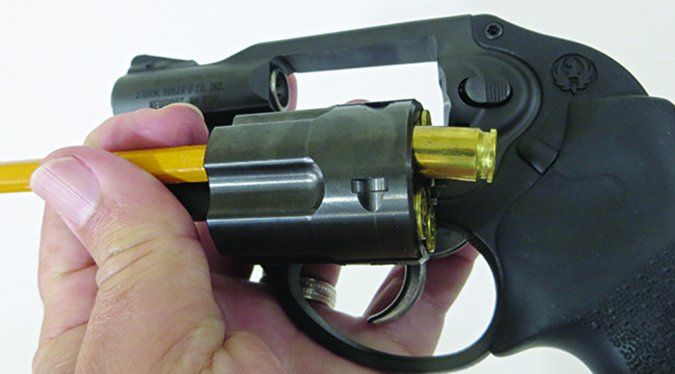
Because these are lightweight revolvers, we checked them to see if bullets would begin to pull out of the case due to the revolver’s light weight and recoil. This is typically an issue with lead bullets, but it can happen with jacketed ammo. The OAL of our 115-grain bullet handload measured 1.07 inches. We loaded a test cartridge, along with four others of the same, in a moon clip and fired four rounds, then measured the fifth round to see if the bullet was working its way out of the case. We noted the OAL was now 1.11 inches, so the bullet had begun to work its way out of the case by 0.04 inches. This is worth noting but it isn’t a major concern with these 9mm revolvers, because there is a lot of space in the chamber from the tip of a cartridge to the front of the cylinder — about a half-inch on both the Ruger and Taurus with 147-grain FMJ bullets. With lighter (shorter) bullets, the space is slightly more. Even if the crimp begins to fail, as we saw with the handloaded cartridges, and the bullet partially works its way out the case, the cylinder will still rotate without fear of binding on a dislodged bullet. This is another good reason to test-fire your actual defense ammo in your revolver. Here’s what else we found about these 9mm revolvers:
Taurus 905 Model 905SS9mm Luger, $528
GUN TESTS GRADE: B
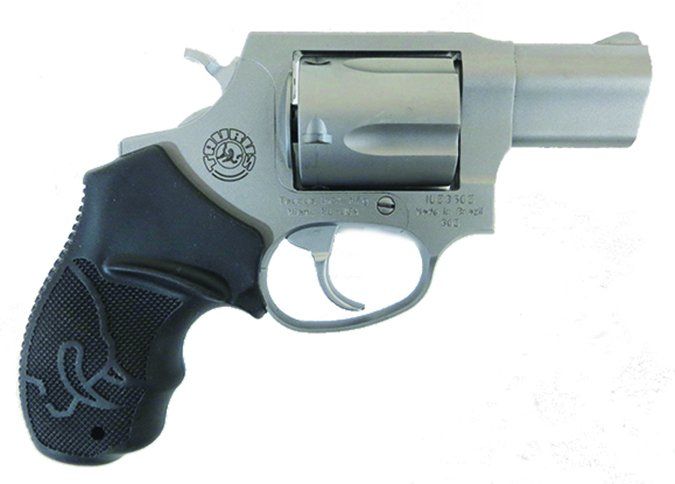
The 905 was faster to reload than a traditional 38 Special and performed well. The trigger and sights were serviceable, and that is reflected in the lower cost.
| ACTION TYPE | Double-action revolver |
| OVERALL LENGTH | 6.5 in. |
| BARREL LENGTH | 2 in. |
| SIGHT RADIUS | 4 in. |
| OVERALL HEIGHT | 4.37 in. |
| MAX WIDTH | 1.3 in. |
| WEIGHT UNLOADED | 22.2 oz. |
| WEIGHT LOADED | 24.2 oz. |
| CYLINDER GAP | 0.007 in. |
| CAPACITY | 5 |
| FRAME FINISH | Matte stainless |
| BARREL/CYLINDER FINISH | Matte stainless |
| FRAME FRONT STRAP HEIGHT | 2.1 in. |
| FRAME BACK STRAP HEIGHT | 3 in. |
| GRIP | Checkered rubber |
| GRIP THICKNESS | 1.1 in. |
| GRIP CIRCUMFERENCE | 4.75 in. |
| FRONT SIGHT | Ramped blade |
| REAR SIGHT | Fixed groove |
| TRIGGER PULL WEIGHT (SA) | 4.8 lbs. |
| TRIGGER PULL WEIGHT (DA) | 14 lbs. |
| SAFETY | Transfer bar, security lock |
| WARRANTY | Lifetime Limited |
| TELEPHONE | (800) 327-3776 |
| WEBSITE | TaurusUSA.com |
| MADE IN | Brazil |
This is the actual sales price at Gallery of Guns’ Gun Genie. The 905 is a traditional snubnose constructed of stainless steel and wearing a non-glare matte finish. Metalwork was well executed, and we noted that Taurus has rearranged its roll marks. The caliber marking is found on the bottom side of the barrel lug and is marked “9mm Para.” with no indication if the revolver is safe for +P or +P+ loads. A look through the manual indicated the Taurus revolver can handle +P loads, but not +P+. It also states using +P loads “…may affect the useful life of the firearm….” The Taurus logo was located on the right side of the revolver on the sideplate and was well executed. The hammer and trigger had a brighter finish. The trigger was smooth, and the hammer spur was well checkered for thumb cocking and single-action shooting. The cylinder locked up in the rear, and a detent at the top of the crane snapped into a notch in the frame. The ejector rod was housed in a full-length barrel shroud. The cylinder latch was low profile, so it was not in the way when loading the moon clips. The cylinder locked up tight with the crane and frame.
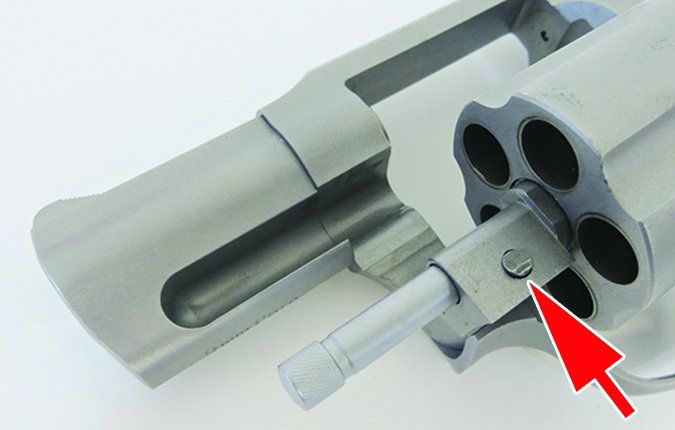
Sights consisted of a serrated-ramp front-sight blade machined into the barrel. A groove along the top strap served as the rear sight, with a U-shaped notch at rear that helped contrast the front sight from the rear. We thought the sights were serviceable but not super. The muzzle was crowned to protect the rifling from damage.
The 905 also sports Taurus’ new rubber grip, which has finger grooves, left and right palm swells, and texture on the sides and backstrap. A ridge on each side of the grip for right- or left-handed shooters positions the second finger almost level with the bottom of the trigger guard. We thought the grips were well executed and did a good job of filling up the space behind the trigger guard. We did note that the design of the LCR allowed for a higher grip, which we preferred. A roll-pin punch and hammer is required to remove the grip from the Taurus. These grips were smaller than the Ruger’s grips.
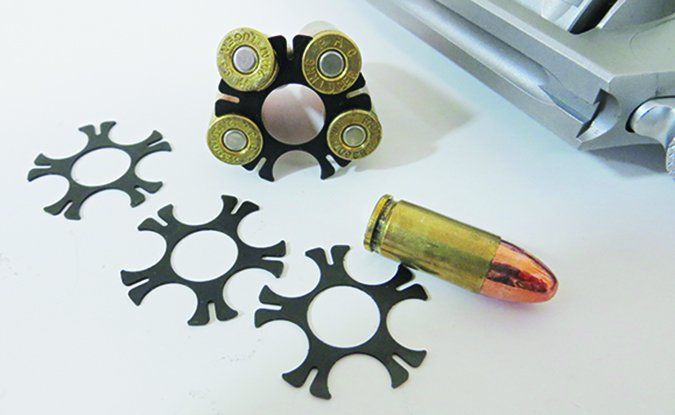
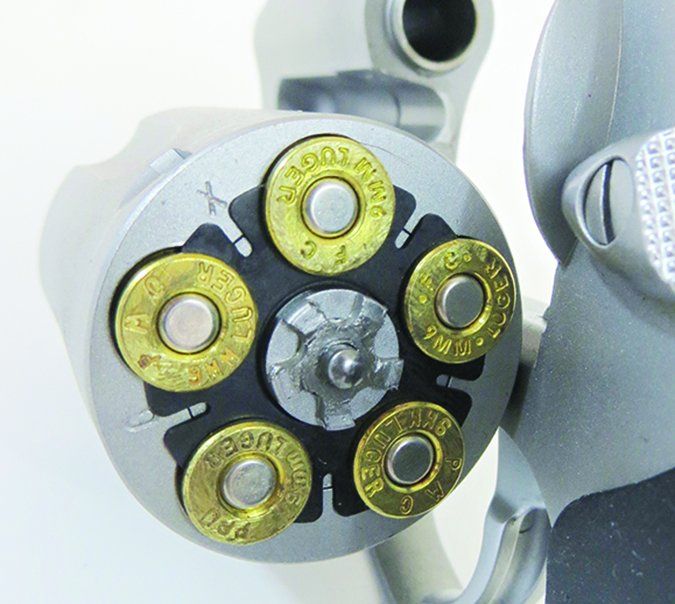
The 905 has a transfer-bar system, so the revolver is safe to carry with all five chambers loaded. A security system can be engaged via a key in the rear of the hammer that locks the works and disables the revolver when stored.
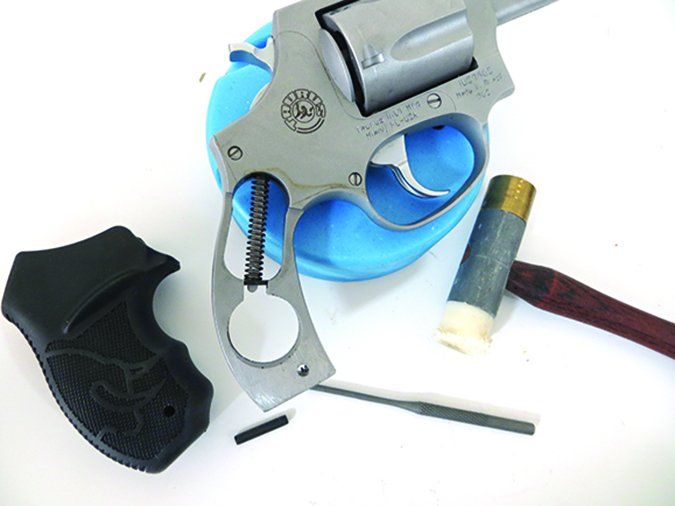
The Taurus has the ability to be fired both single action and double action, and the SA fire was an advantage during accuracy testing because the Taurus had a DA trigger-pull weight of about 14 pounds. We did experience stacking in DA, meaning there was a perceptible amount of additional finger press needed to fire the revolver near the end of the trigger cycle. The trigger on the Ruger was much smoother and lighter, in our opinion. In our speed drill, firing five shots as fast as possible at a target 7 yards away, testers could control the Ruger better due to the grip design. The Taurus was very controllable, but the Ruger had an edge.
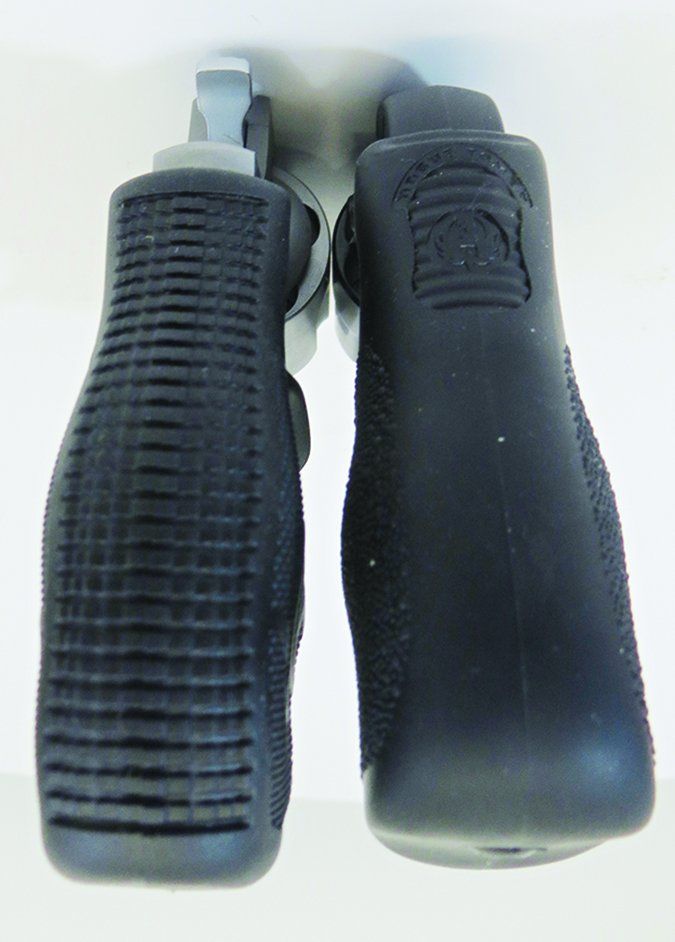
The moon clips were easy to load and unload empty cases, and unlike 45 ACP moon clips, these clips do not need a case removal tool. Instead, the cases come off easily, using your fingers. Some were even loose, so if they are carried in a pocket, a cartridge may fall out during everyday carry. We’d make sure the spare moon clip has a good purchase on the cartridges and carry the clips in a spare ammo carrier like you would a speedloader. They do bend easily, so acquiring more clips is a good idea because they will not last the life of the revolver like a magazine may with a pistol. The 905 and LCR 9mm can be loaded with 9mm cartridges without the moon clip, but empty cases need to be manually ejected with a rod. We liked this feature as a fail safe, but would hate to be in a situation where we needed to poke out those empties. All the more reason to carry extra moon clips.
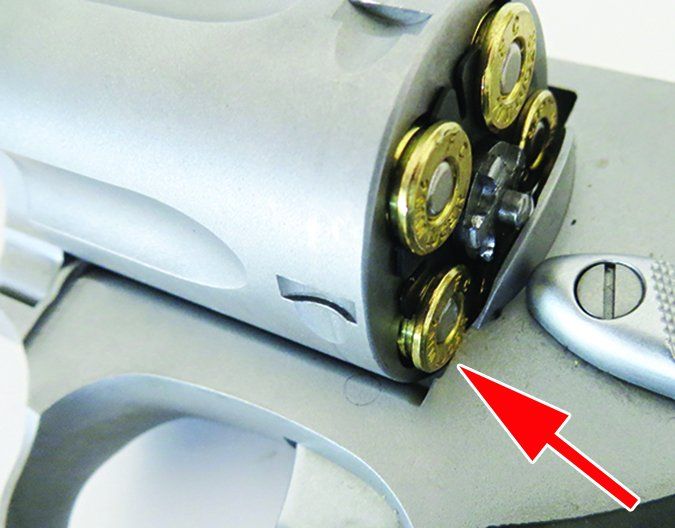
At the range, the 905 was easy to control, even with the snappy Win. NATO 124-grain cartridges. The new-style grip helped to control and spread recoil better in the palm of our hands. The front sight in bright light was difficult to see for accuracy work, but at close range it was adequate. After extensive shooting, about 200 rounds, we noticed the 905 was more difficult to load due to fouling. We also noticed we had to be sure the cartridges were set fully in the chambers. If they were not, the case rim would catch on the side of the frame and prevent closing the cylinder. Because these revolvers are not designed for extended shooting sessions, we’d advise to give it a thorough cleaning after each use. We did not experience this issue with the LCR, but we did notice brass marks on the LCR’s frame, indicating some cartridge rims rubbed against its frame as well.
Our Team Said: The Model 905 is a sturdy revolver, what we have come to expect in a traditional snubnose. We felt the new-style grips were comfortable without adding bulk. The trigger pull was heavy in double action, but it had the ability to be fired single action.
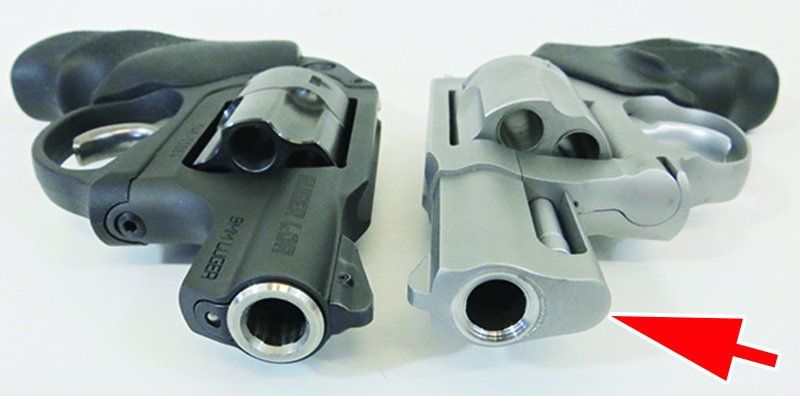
Ruger LCR Model 5456 9mm Luger, $532
GUN TESTS GRADE: A-
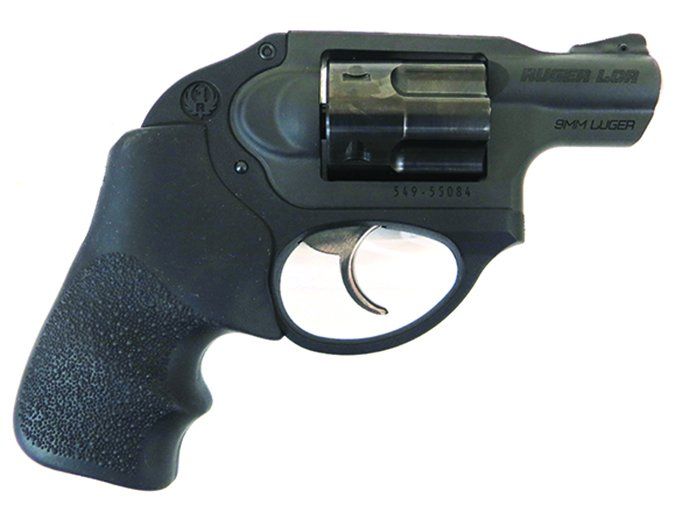
The LCR has a buttery-smooth trigger, and the grip design stands out from traditional snub-nose revolvers. Plus, it is lightweight.
| ACTION | Double-action-only revolver |
| OVERALL LENGTH | 6.5 in. |
| BARREL LENGTH | 1.875 in. |
| SIGHT RADIUS | 3.5 in. |
| OVERALL HEIGHT | 4.5 in. |
| MAX WIDTH | 1.3 in. |
| WEIGHT UNLOADED | 17.2 oz. |
| WEIGHT LOADED | 19.2 oz. |
| CYLINDER GAP | 0.007 in. |
| CAPACITY | 5 |
| FRAME FINISH | Matte black |
| BARREL/CYLINDER FINISH | Matte black |
| FRAME FRONT STRAP HEIGHT | 1.7 in. |
| FRAME BACK STRAP HEIGHT | 3 in. |
| GRIP | Hogue Tamer Monogrip |
| GRIP THICKNESS | 1.2 in. |
| GRIP CIRCUMFERENCE | 5.2 in. |
| FRONT SIGHT | Ramped blade |
| REAR SIGHT | Fixed groove |
| TRIGGER PULL WEIGHT | 10.5 lbs. |
| SAFETY | Transfer bar |
| WARRANTY | None |
| TELEPHONE | (928) 541-8892 |
| WEBSITE | Ruger.com |
| MADE IN | USA |
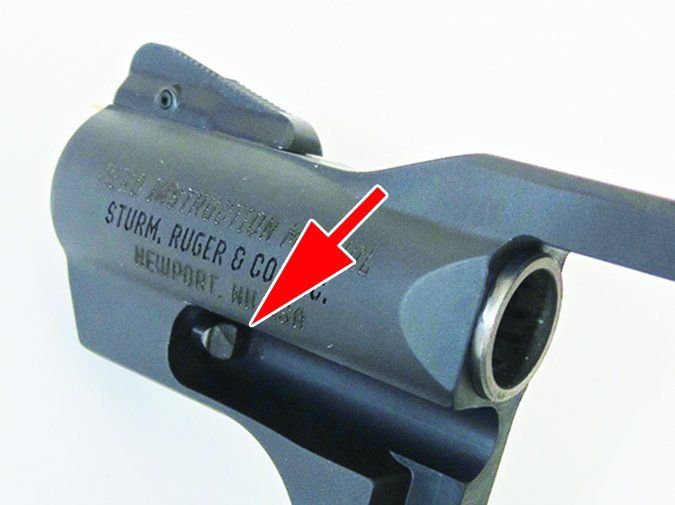
This is the average price of the 5456 offered by five retailers through the Gallery of Guns app on the Ruger website. The LCR (Light Compact Revolver) is a different breed of snubnose using polymer, aluminum, and steel construction. A polymer fire-control housing is the grip and trigger guard portion of the revolver, while the frame assembly is aluminum, with a stainless-steel barrel sleeve in the frame. The cylinder is stainless steel and is traditionally fluted, unlike the radically fluted cylinder of the LCR 38 Special +P model. The Ruger was five ounces lighter than the Taurus, which is significant especially for a daily carry gun, but 3.7 ounces heavier than the LCR 38 Special model. It came with a soft case and cable lock. The LCR also uses a transfer bar safety system that enables the hammer to hit the firing pin only when the trigger is pulled all the way to the rear. So it is safe to carry fully loaded.
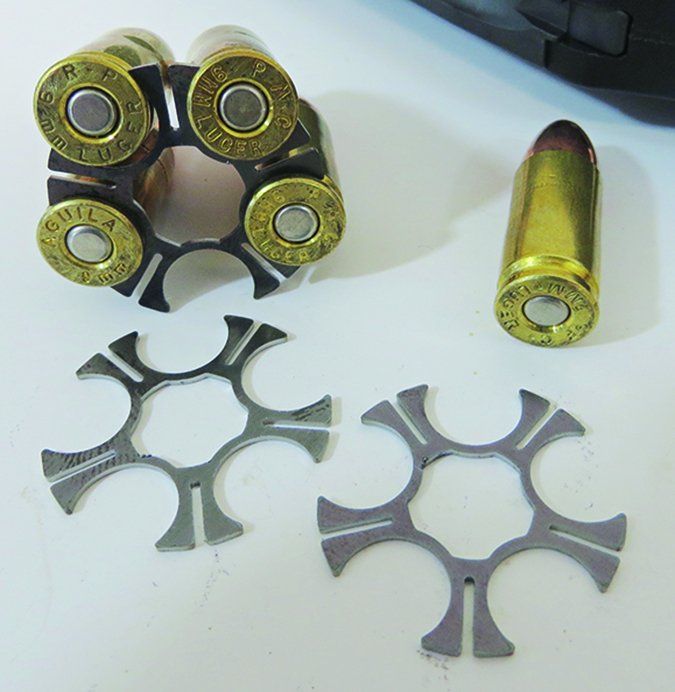
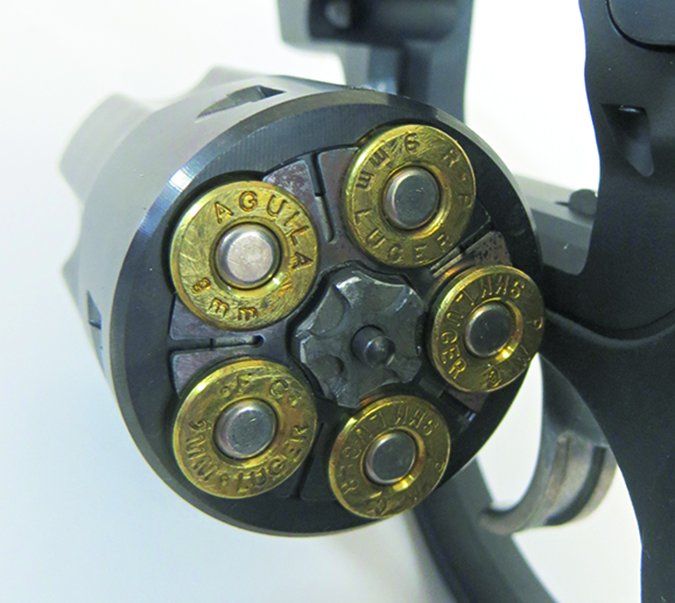
The matte finish was well executed, and we anticipate the polymer/steel portions to wear similar to a polymer/steel semi-auto. The trigger was smooth and felt much lighter than 10.5 pounds due to the friction-reducing cam-fire system. The trigger pull was also smooth, without stacking effect — noticeably better than the Taurus. The cylinder latch on the LCR is squeezed rather than pushed forward like on the Taurus or an S&W revolver. Manipulating latches of both revolvers was solid and precise. The end of the ejector rod on the Ruger LCR 9mm engages a pin in the shroud, locking up the front and via the ejector in the rear. Lock up was tight, and there was little play side to side or front to rear. Both revolvers locked up tight.
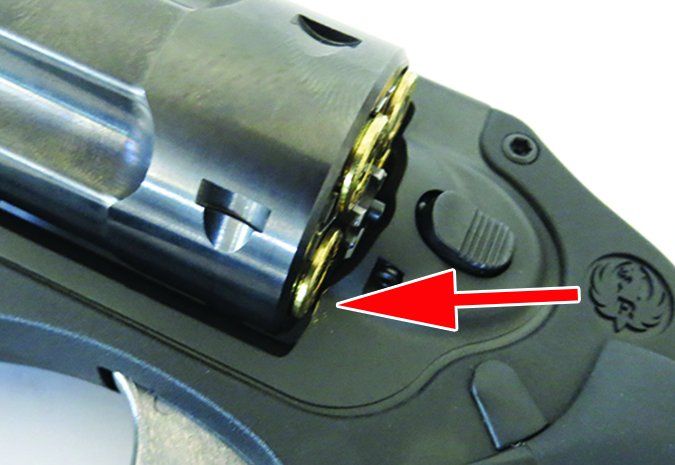
The sights were similar to those on the Taurus, except the ramped front-sight blade was pinned in place and replaceable or can be modified for a certain load. It also has a white strip on it so it is easier to acquire. The rear sight is a groove along the top strap that seamlessly blends into the arched portion of the frame covering the hammer. In our view, the LCR had more user-friendly sights and were a plus.
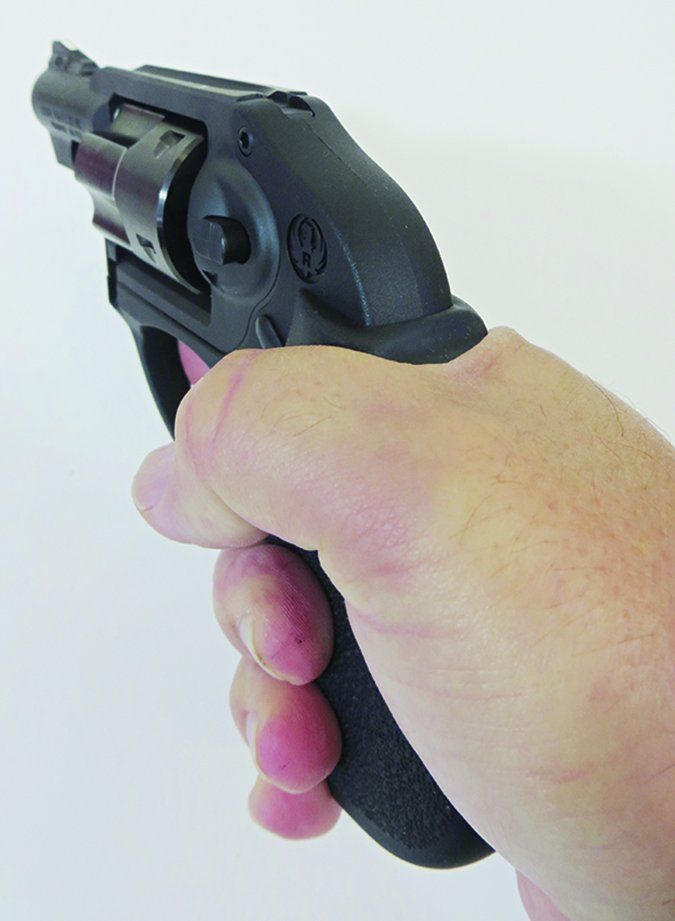
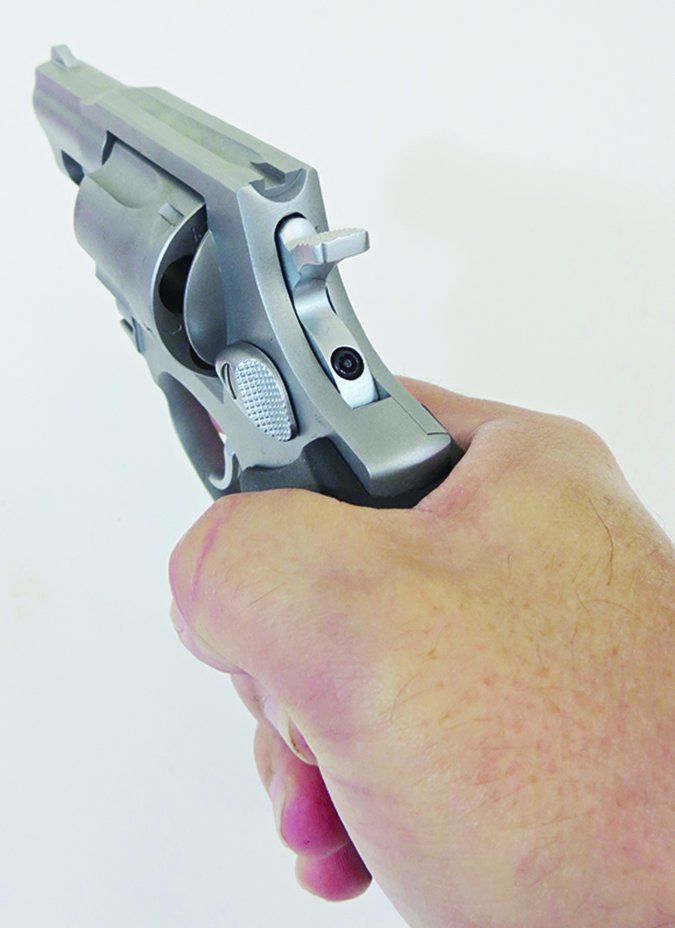
The Hogue Tamer grip had a pebbled texture on the sides, palm swells for both left- and right-hand shooters, and finger grooves. Where the web of the shooter’s hand contacts the grip is embellished with the Ruger logo. We also found a section of squishy blue rubber on the inside of the grip for absorbing more recoil. The grip felt good in hand, but was slightly larger than the 905 grip, something our testers thought would make the LCR print or hinder a draw from a pants pocket holster, depending on the size of your pocket. The rubber-to-metal fit of the grips of both guns was excellent. Overall, the Ruger had a smoother outside surface than the Taurus. The hammer was the obvious culprit in a pocket-draw snag with the Taurus.
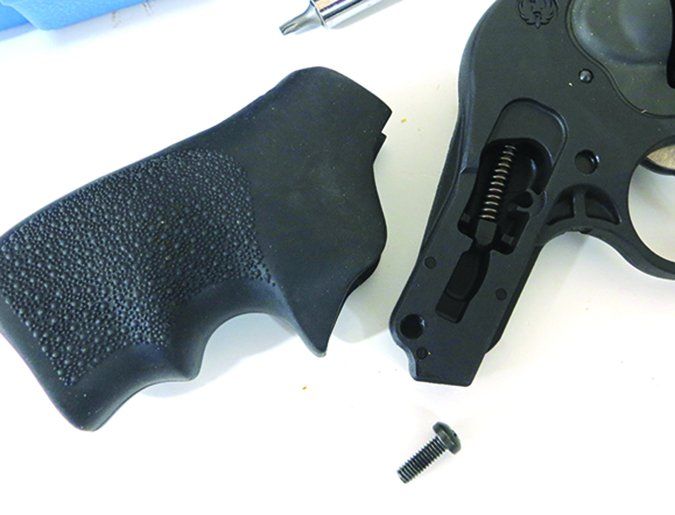
The ejector rod pushed empties to the very edge of the chamber; a gravity assist is needed to completely eject the cases. The LCR will fire 9mm cartridges without the moon clips, but it will not eject the empty case. A pencil or some other long skinny object is need to eject empties.
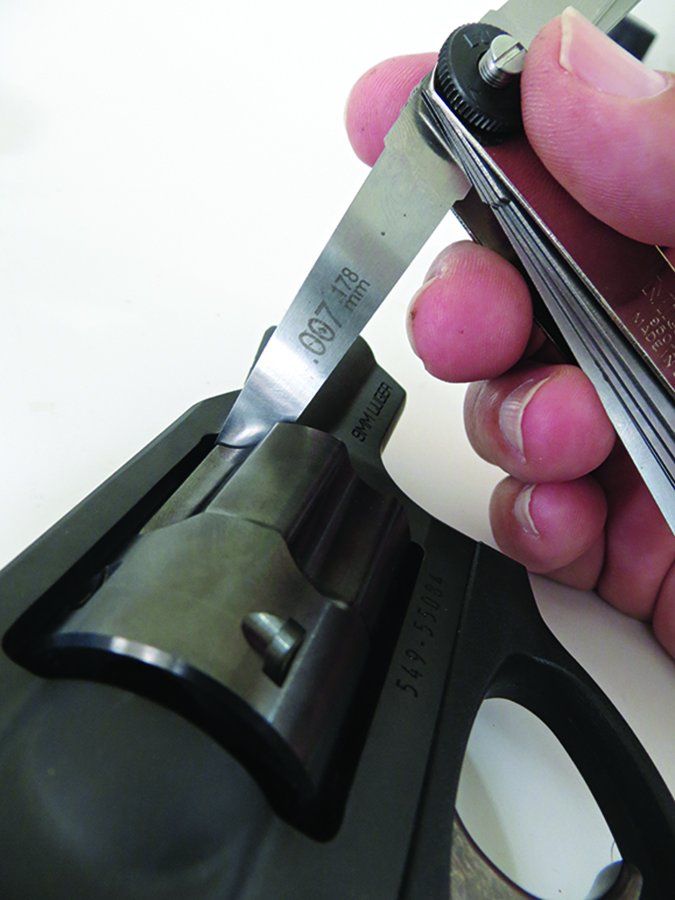
At the range, we found the LCR to be noticeably lighter than the 905. It also allowed a higher grip on the revolver, which means placing the center line of the bore closer to the shooter’s hand, reducing felt recoil. Indeed, we thought the LCR shot softer and produced less muzzle flip, particularly in rapid fire. Both revolvers had similar accuracy and pointability. In extended fire, we had no issues reloading or closing the cylinder, like we did with the 905.
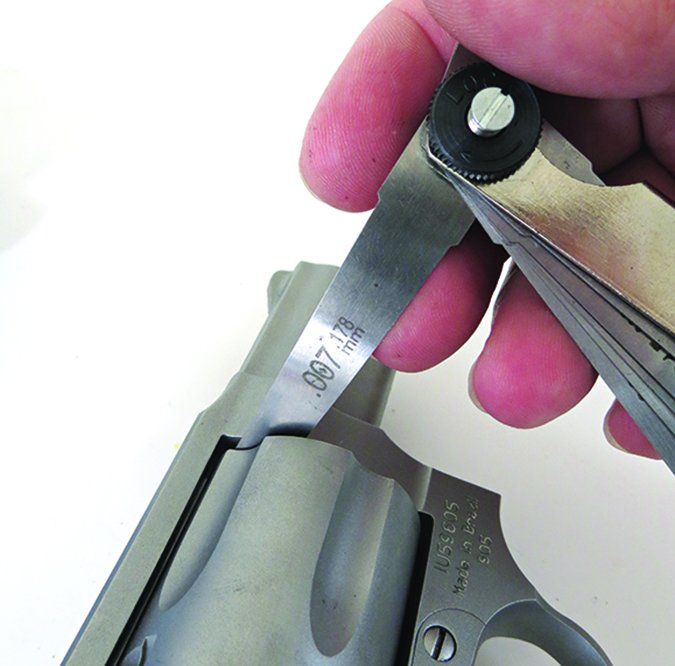
Our Team Said: The more time we spent with the LCR 9mm, the more we came to appreciate the smooth trigger and grip design, which makes this non-traditional revolver easy to shoot and manipulate. We’d buy this revolver for concealed carry use or home defense.
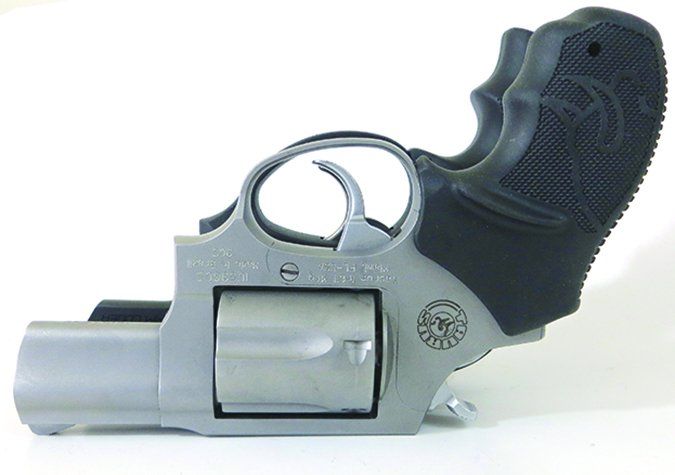
Written and photographed by Robert Sadowski, using evaluations fromGun Teststeam testers.



























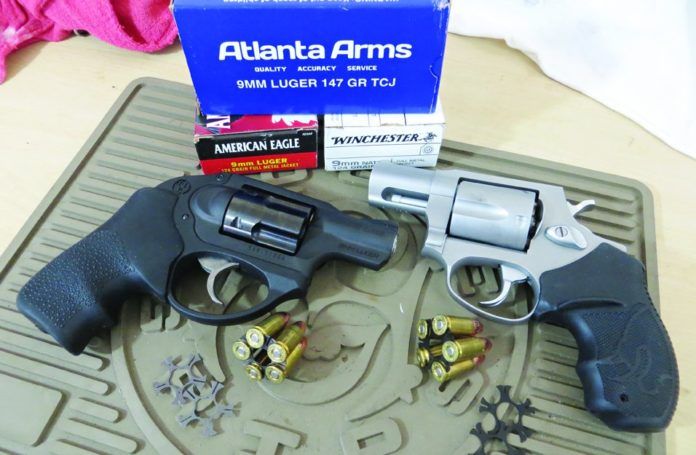


Why viewers still make use of to read news papers when in this technological globe all is presented on net?